Full-Scale Modeling and FBGs Experimental Measurements for Thermal Analysis of Converter Transformer
Abstract
1. Introduction
2. Methodology
3. Model Description
3.1. Full-Scale Model
3.2. Fundamental Parameters and Boundary Conditions
3.3. Mesh Division
4. Simulation Results and Discussion
4.1. Axial Direction Temperature
4.2. Radial Direction Temperature
4.3. Temperature Distribution
5. Temperature Rise Test and Analysis
5.1. Construction of Experimental Platform
5.2. Experimental Results and Discussion
5.2.1. Axial Temperature Characteristics
5.2.2. Radial Direction Temperature
6. Conclusions
- (1)
- The axial temperature distribution of the windings demonstrates a progressive increase from bottom to top. Significant changes in flow velocity on either side of the oil duct barriers markedly impact the cooling effect, resulting in temperature within each winding section first increasing and then decreasing. The maximum radial temperatures are observed at positions adjacent to the two-column windings, decreasing gradually toward the outer side;
- (2)
- With increasing loading ratios, the time for the transformer to reach a steady state decreases, but the temperature differences between the HV and LV windings, as well as among the top, middle, and bottom of the windings, increase. At a 120% loading ratio, the maximum temperature can reach 107.9 °C, with the largest temperature difference being up to 35.4 °C;
- (3)
- The establishment of the full-scale model significantly enhances the precision of simulation calculations. According to the data collected by the FBG sensors, the validation results for the coupled calculation model indicate that the error during the transition from rated operation to steady state is less than 2.3%.
Author Contributions
Funding
Institutional Review Board Statement
Informed Consent Statement
Data Availability Statement
Conflicts of Interest
References
- Gezegin, C.; Ozgonenel, O.; Dirik, H. A monitoring method for average winding and hot-spot temperatures of single-phase, oil-immersed transformers. IEEE Trans. Power Deliv. 2020, 36, 3196–3203. [Google Scholar] [CrossRef]
- Xiao, D.; Xiao, R.; Yang, F.; Chi, C.; Hua, M.; Yang, C. Simulation research on ONAN transformer winding temperature field based on temperature rise test. Therm. Sci. 2022, 26 Pt A, 3229–3240. [Google Scholar] [CrossRef]
- Kebriti, R.; Hossieni, S.M.H. 3D modeling of winding hot spot temperature in oil-immersed transformers. Electr. Eng. 2022, 104, 3325–3338. [Google Scholar] [CrossRef]
- Ai, M.; Shan, Y. The whole field temperature rise calculation of oil-immersed power transformer based on thermal network method. Int. J. Appl. Electromagn. Mech. 2022, 70, 55–72. [Google Scholar] [CrossRef]
- Liu, C.; Hao, J.; Liao, R.; Yang, F.; Li, W.; Li, Z. Magnetic flux leakage, eddy current loss and temperature distribution for large scale winding in UHVDC converter transformer based on equivalent 2D axisymmetric model. Electr. Eng. 2024, 106, 711–725. [Google Scholar] [CrossRef]
- Shiravand, V.; Faiz, J.; Samimi, M.H.; Djamali, M. Improving the transformer thermal modeling by considering additional thermal points. Int. J. Electr. Power Energy Syst. 2021, 128, 106748. [Google Scholar] [CrossRef]
- Li, L.; Liu, W.; Chen, H.; Liu, X. Prediction of oil flow and temperature distribution of transformer winding based on multi-field coupled approach. J. Eng. 2019, 2019, 2007–2012. [Google Scholar] [CrossRef]
- Yu, X.; Tan, Y.; Wang, H.; Wang, X.; Zang, Y.; Guo, P. Thermal analysis and optimization on a transformer winding based on non-uniform loss distribution. Appl. Therm. Eng. 2023, 226, 120296. [Google Scholar] [CrossRef]
- Córdoba, P.A.; Dari, E.; Silin, N. A 3D numerical model of an ONAN distribution transformer. Appl. Therm. Eng. 2019, 148, 897–906. [Google Scholar] [CrossRef]
- Yuan, F.; Wang, Y.; Tang, B.; Yang, W.; Jiang, F.; Han, Y.; Han, S.; Ding, C. Heat dissipation performance analysis and structural parameter optimization of oil-immersed transformer based on flow-thermal coupling finite element method. Therm. Sci. 2022, 26 Pt A, 3241–3253. [Google Scholar] [CrossRef]
- Gao, C.; Huang, L.; Feng, Y.; Gao, E.; Yang, Z.; Wang, K. Thermal field modeling and characteristic analysis based on oil immersed transformer. Front. Energy Res. 2023, 11, 1147113. [Google Scholar] [CrossRef]
- Shiravand, V.; Faiz, J.; Samimi, M.H.; Mehrabi-Kermani, M. Prediction of transformer fault in cooling system using combining advanced thermal model and thermography. IET Gener. Transm. Distrib. 2021, 15, 1972–1983. [Google Scholar] [CrossRef]
- Ni, R.; Chen, J.; Yang, C.; Li, C.; Qiu, R.; Liu, Z.; Li, R.; Gao, L.; Li, Y. A temperature calculation method of oil immersed transformer considering delay effects and multiple environmental factors. Electr. Power Syst. Res. 2022, 213, 108260. [Google Scholar] [CrossRef]
- Mikhak-Beyranvand, M.; Faiz, J.; Rezaeealam, B. Thermal analysis and derating of a power transformer with harmonic loads. IET Gener. Transm. Distrib. 2020, 14, 1233–1241. [Google Scholar] [CrossRef]
- Aslam, M.; Haq, I.U.; Rehan, M.S.; Basit, A.; Arif, M.; Khan, M.I.; Sadiq, M.; Arbab, M.N. Dynamic thermal model for power transformers. IEEE Access 2021, 9, 71461–71469. [Google Scholar] [CrossRef]
- Daghrah, M.; Zhang, X.; Wang, Z.; Liu, Q.; Jarman, P.; Walker, D. Flow and temperature distributions in a disc type winding-part I: Forced and directed cooling modes. Appl. Therm. Eng. 2020, 165, 114653. [Google Scholar] [CrossRef]
- Liu, G.; Zheng, Z.; Ma, X.; Rong, S.; Wu, W.; Li, L. Numerical and experimental investigation of temperature distribution for oil-immersed transformer winding based on dimensionless least-squares and upwind finite element method. IEEE Access 2019, 7, 119110–119120. [Google Scholar] [CrossRef]
- Zhang, X.; Wang, Z.; Liu, Q.; Jarman, P.; Negro, M. Numerical investigation of oil flow and temperature distributions for ON transformer windings. Appl. Therm. Eng. 2018, 130, 1–9. [Google Scholar] [CrossRef]
- Chi, C.; Gao, B.; Yang, F.; Liao, R.; Cheng, L.; Zhang, L. Investigation on the nonlinear thermal-electrical properties coupling performance of converter transformer. Appl. Therm. Eng. 2019, 148, 846–859. [Google Scholar] [CrossRef]
- Chi, C.; Yang, F.; Xu, C.; Cheng, L.; Yang, C. A multi-scale thermal-fluid coupling model for ONAN transformer considering entire circulating oil systems. Int. J. Electr. Power Energy Syst. 2022, 135, 107614. [Google Scholar] [CrossRef]
- Zhang, H.; Liu, G.; Lin, B.; Deng, H.; Li, Y.; Wang, P. Thermal evaluation optimization analysis for non-rated load oil-natural air-natural transformer with auxiliary cooling equipment. IET Gener. Transm. Distrib. 2022, 16, 3080–3091. [Google Scholar] [CrossRef]
- Bragone, F.; Morozovska, K.; Hilber, P.; Laneryd, T.; Luvisotto, M. Physics-informed neural networks for modelling power transformer’s dynamic thermal behaviour. Electr. Power Syst. Res. 2022, 211, 108447. [Google Scholar] [CrossRef]
- Qu, Y.; Zhao, H.; Zhao, S.; Ma, L.; Mi, Z. Evaluation method for insulation degradation of power transformer windings based on incomplete internet of things sensing data. IET Sci. Meas. Technol. 2024, 18, 130–144. [Google Scholar] [CrossRef]
- Wang, Y.; Shi, C.; Gao, M.; Xu, Y.; Fu, M.; Zhuo, R. Improved thermal hydraulic network modelling and error analysis in disc-type transformer windings. IET Gener. Transm. Distrib. 2024, 18, 202–213. [Google Scholar] [CrossRef]
- Raza, S.A.; Ullah, A.; He, S.; Wang, Y.; Li, J. Empirical Thermal Investigation of Oil-Immersed Distribution Transformer under Various Loading Conditions. CMES-Comput. Model. Eng. Sci. 2021, 129, 829–847. [Google Scholar]
- Zhang, Z.S.; Liu, D.; Liu, B.F.; Shi, X.D.; Liu, Z.Q. Temperature of Transformer Controller Based on TMS320C6713. Adv. Mater. Res. 2013, 823, 555–558. [Google Scholar]
- Susa, D.; Lehtonen, M.; Nordman, H. Dynamic thermal modeling of distribution transformers. IEEE Trans. Power Deliv. 2005, 20, 1919–1929. [Google Scholar] [CrossRef]
- Zhao, J.; Wang, H.; Sun, X. Study on the performance of polarization maintaining fiber temperature sensor based on tilted fiber grating. Measurement 2021, 168, 108421. [Google Scholar] [CrossRef]
- Shi, C.; Ma, G.; Mao, N.; Zhang, Q.; Zheng, Q.; Li, C.; Zhao, S. Ultrasonic detection coherence of fiber Bragg grating for partial discharge in transformers. In Proceedings of the 2017 IEEE 19th International Conference on Dielectric Liquids (ICDL), Manchester, UK, 25–29 June 2017; IEEE: New York, NY, USA, 2017; pp. 1–4. [Google Scholar]
- Sarkar, B.; Koley, C.; Roy, N.; Kumbhakar, P. Condition monitoring of high voltage tranModifiedsformers using Fiber Bragg Grating Sensor. Measurement 2015, 74, 255–267. [Google Scholar] [CrossRef]
- Zhao, Z.Q.; MacAlpine, J.M.K.; Demokan, M.S. Directional sensitivity of a fibre-optic sensor to acoustic signals in transformer oil. In Proceedings of the 4th International Conference on Advances in Power System Control, Operation & Management, Hong Kong, China, 11–14 November 1997; pp. 521–525. [Google Scholar]
- Ruan, J.; Deng, Y.; Huang, D.; Duan, C.; Gong, R.; Quan, Y.; Hu, Y.; Rong, Q. HST calculation of a 10 kV oil-immersed transformer with 3D coupled-field method. IET Electr. Power Appl. 2020, 14, 921–928. [Google Scholar] [CrossRef]
- Amar, M.; Kaczmarek, R. A general formula for prediction of iron losses under nonsinusoidal voltage waveform. IEEE Trans. Magn. 1995, 31, 2504–2509. [Google Scholar] [CrossRef]
- Linan, R.; Ponce, D.; Betancourt, E.; Tamez, G. Optimized models for overload monitoring of power transformers in real time moisture migration model. IEEE Trans. Dielectr. Electr. Insul. 2013, 20, 1977–1983. [Google Scholar] [CrossRef]
- Meitei, S.N.; Borah, K.; Chatterjee, S. Review on monitoring of transformer insulation oil using optical fiber sensors. Results Opt. 2023, 10, 100361. [Google Scholar] [CrossRef]
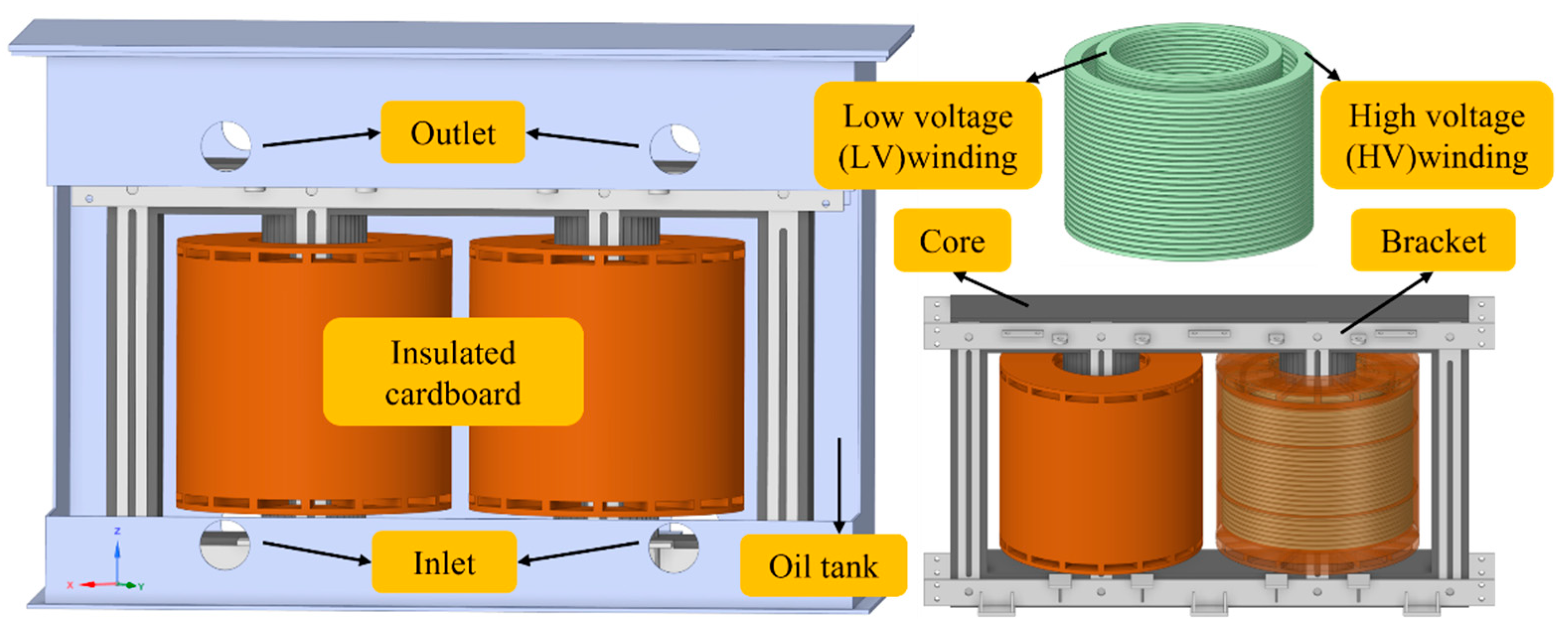


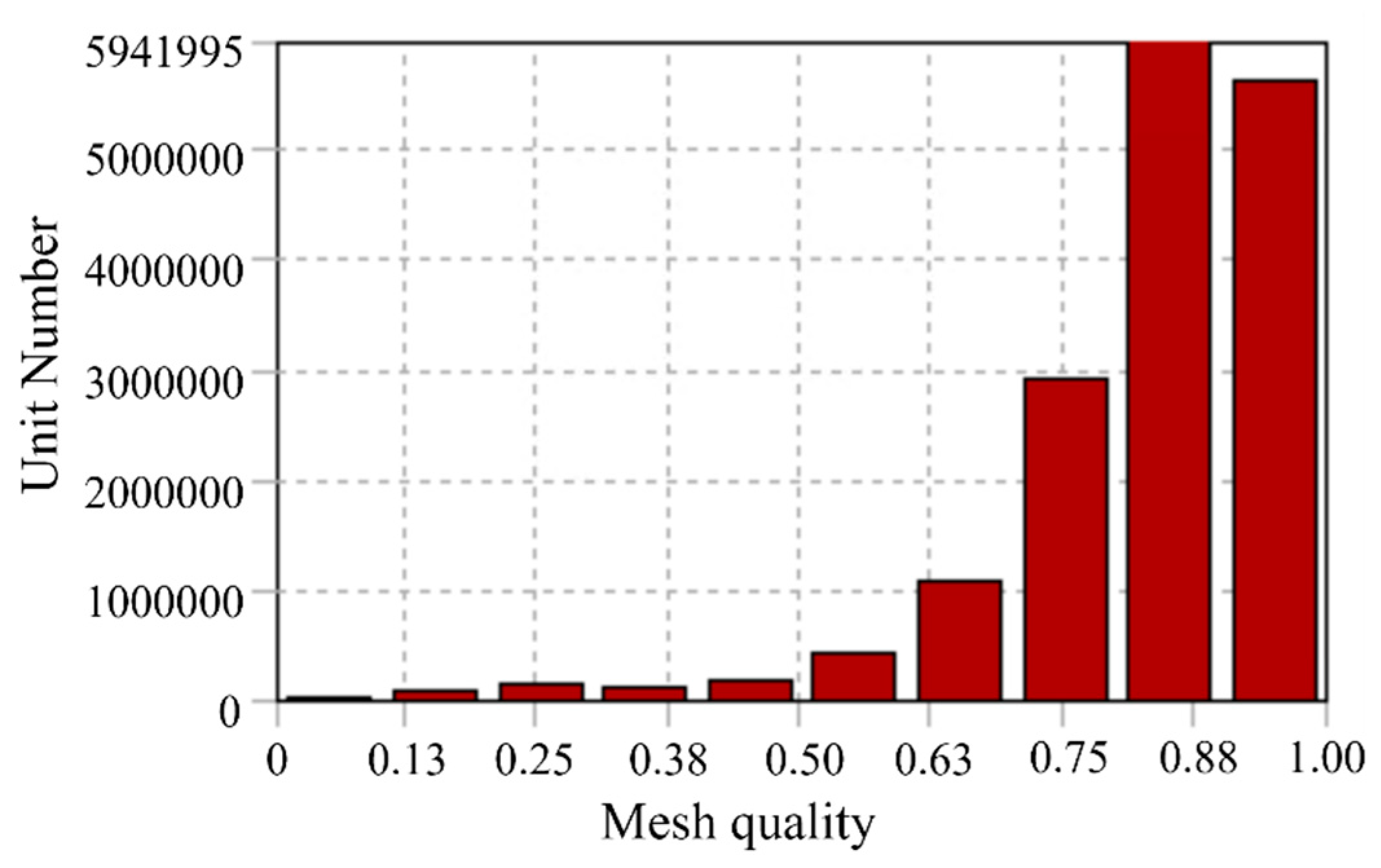

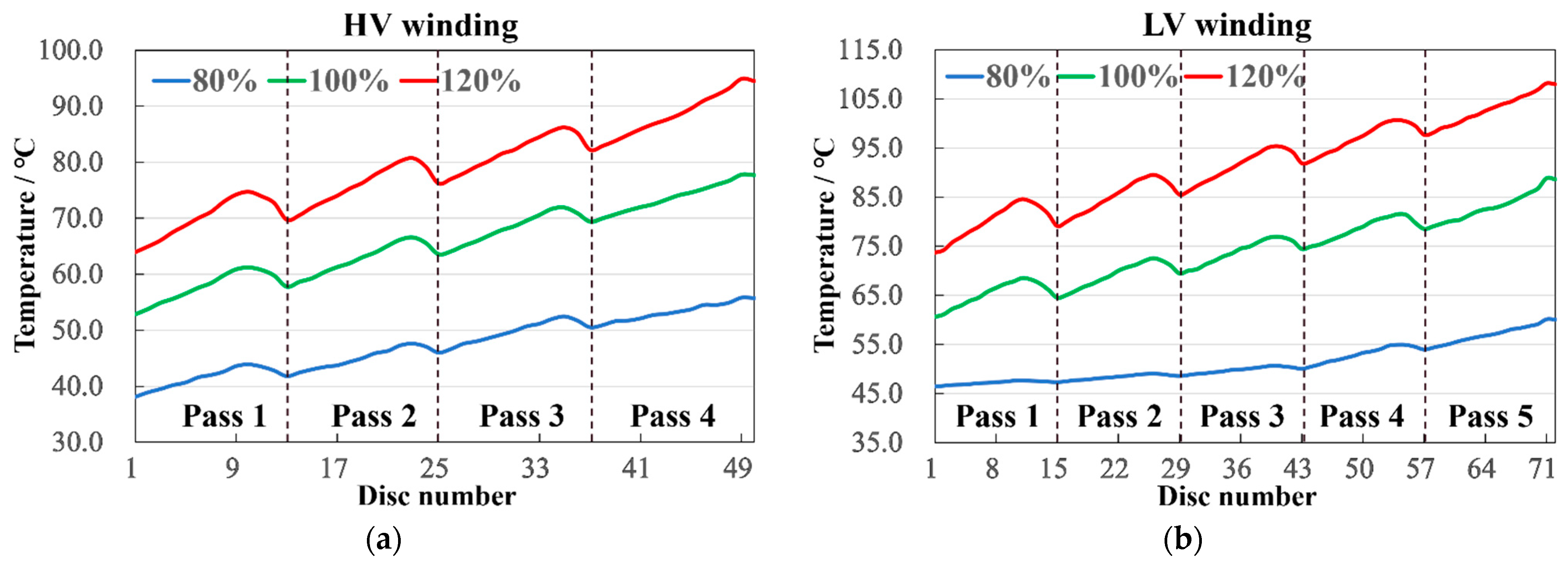
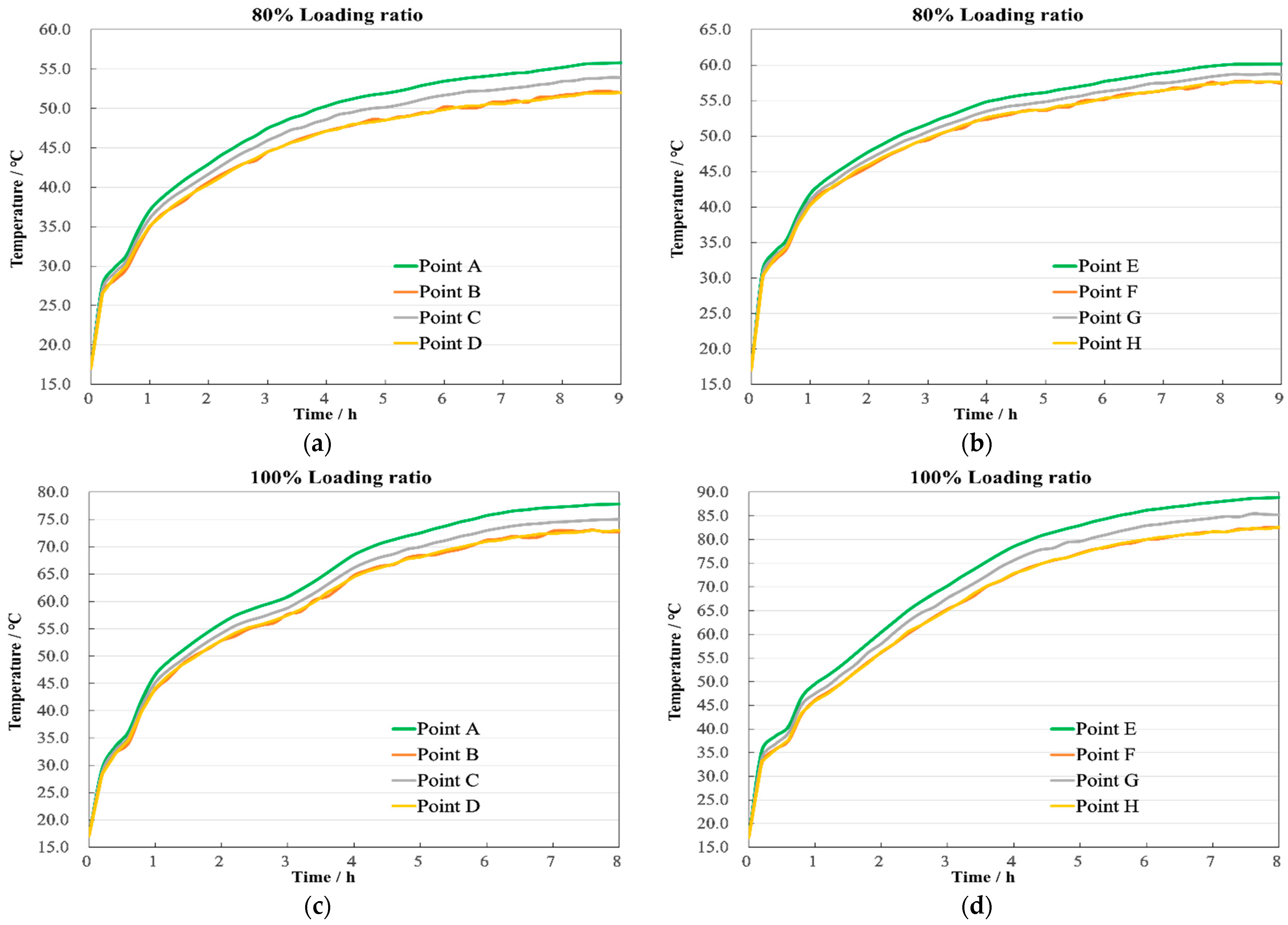
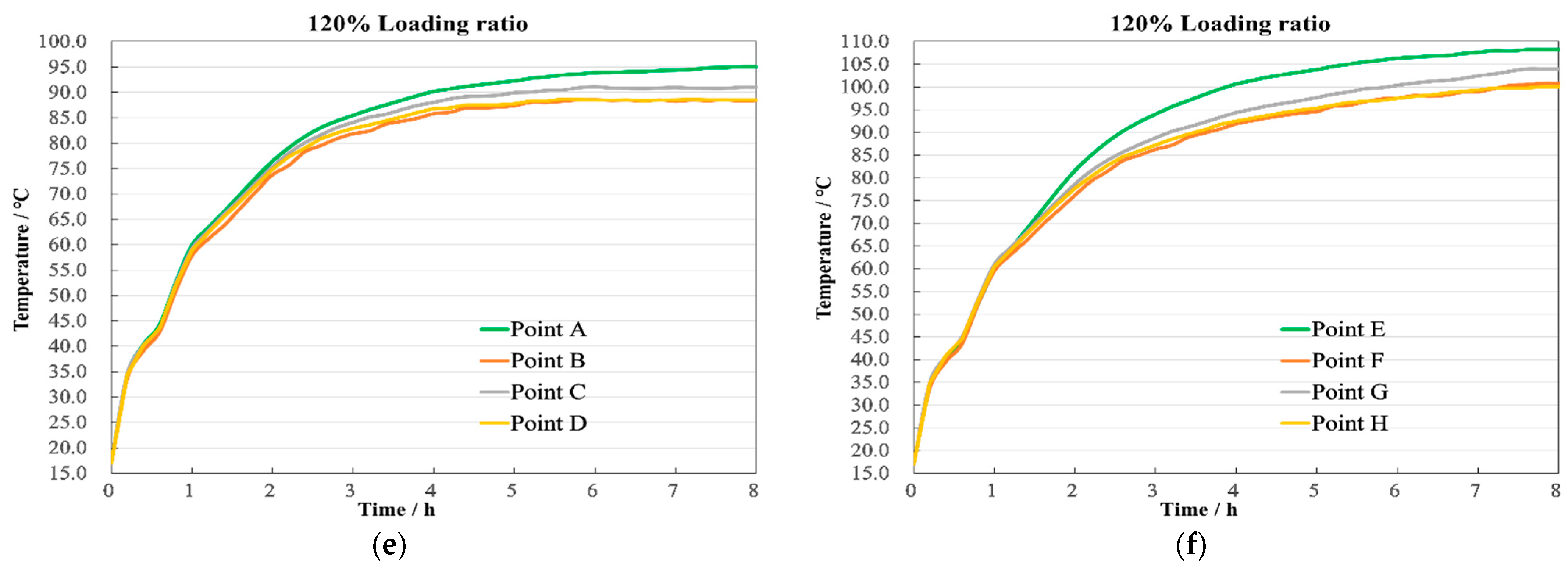
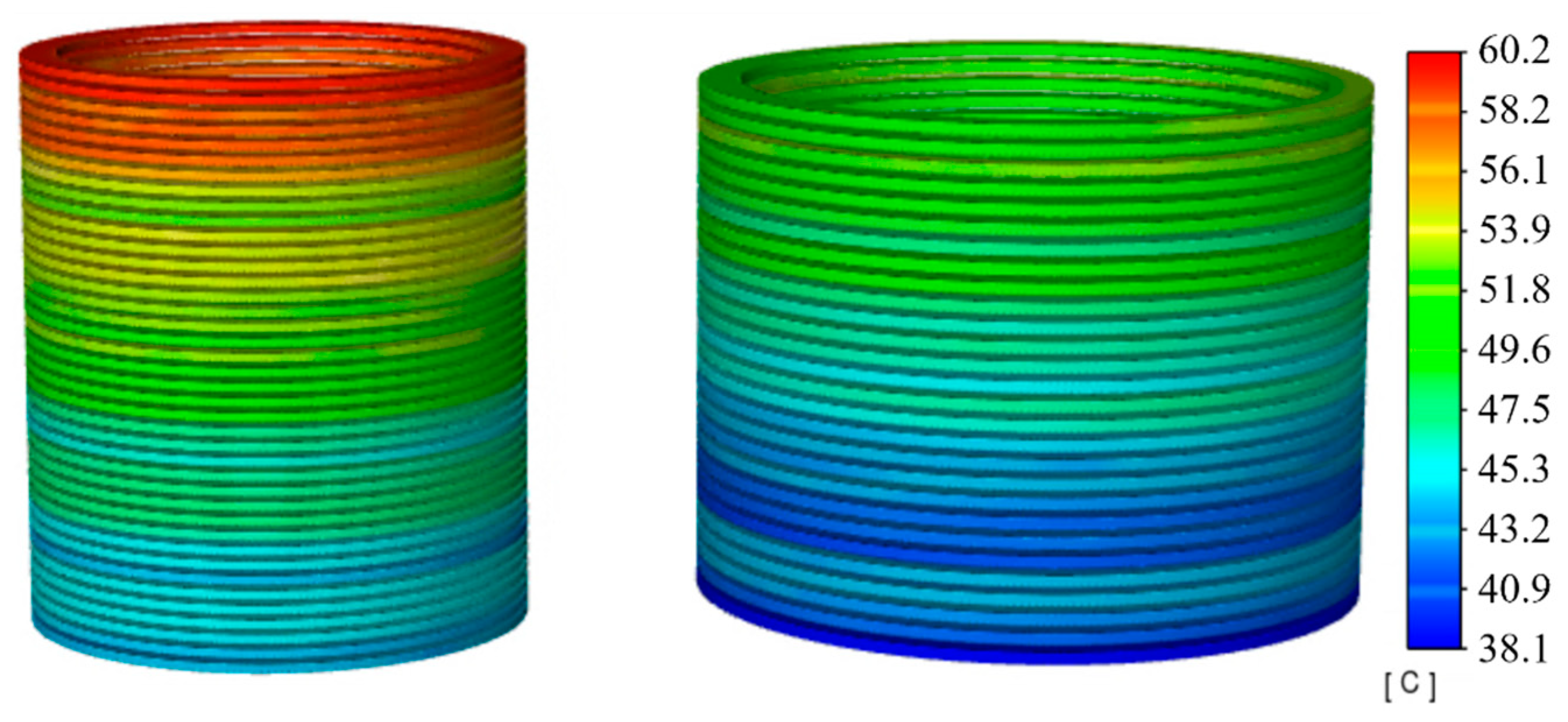

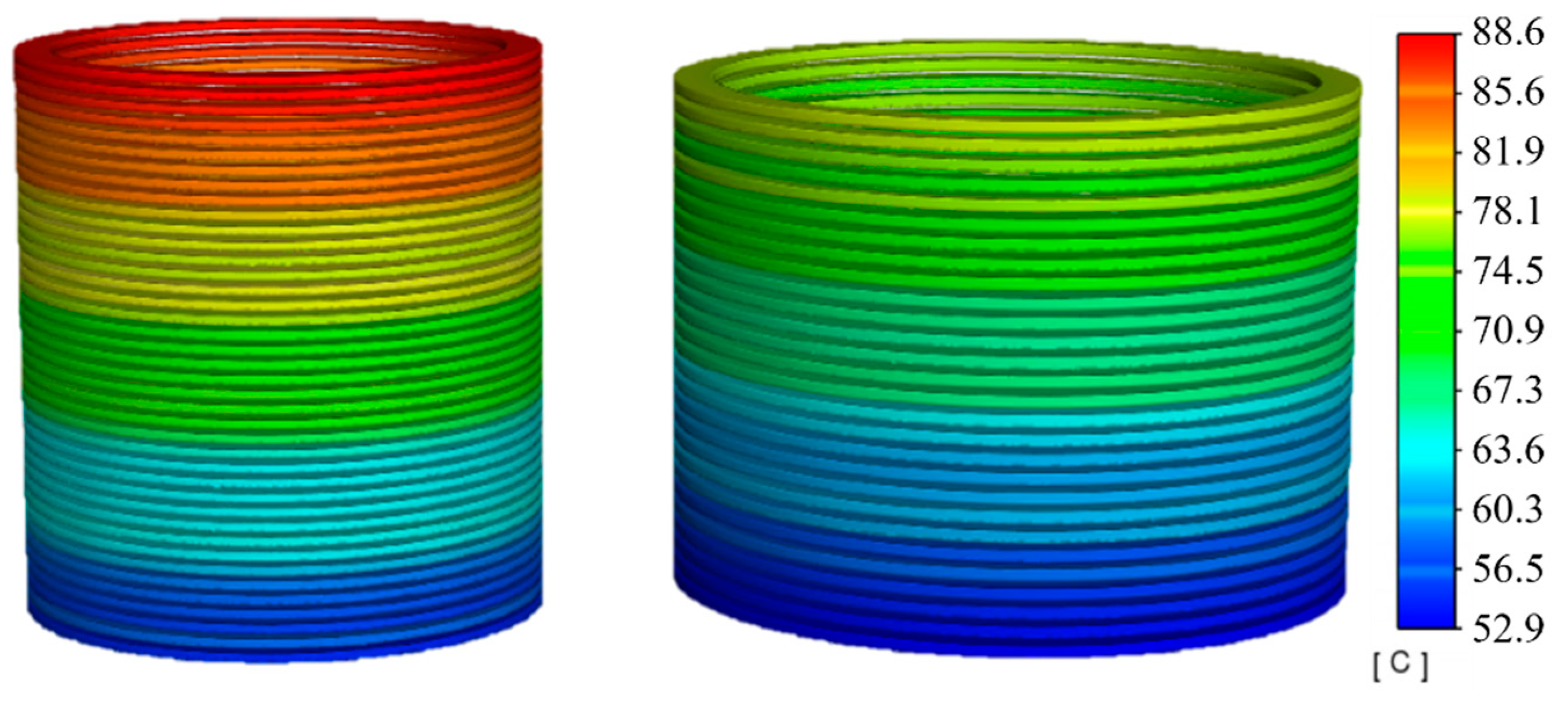
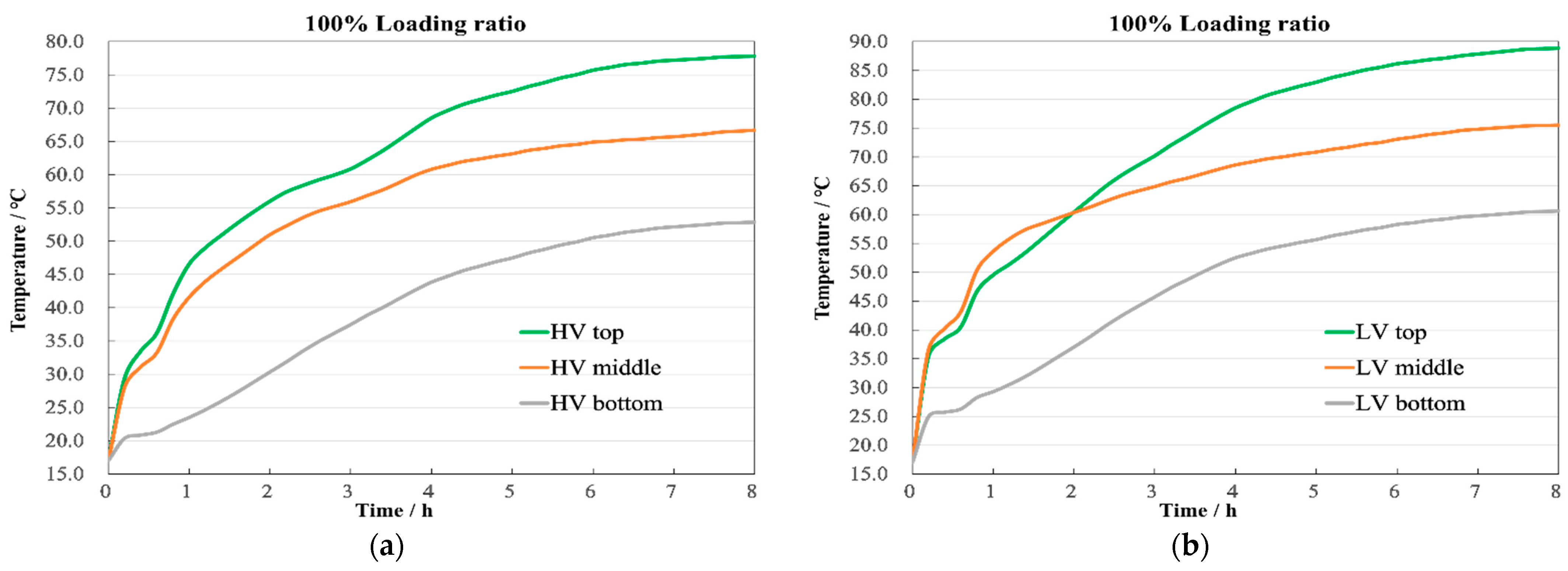

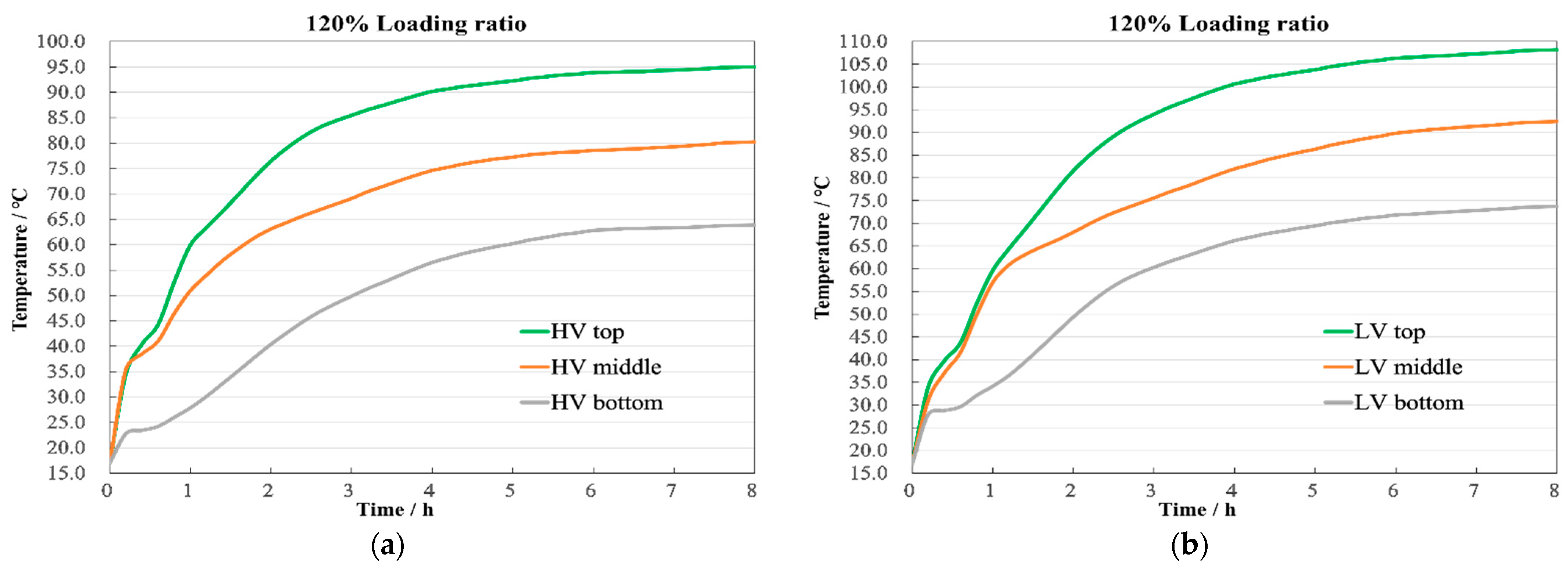


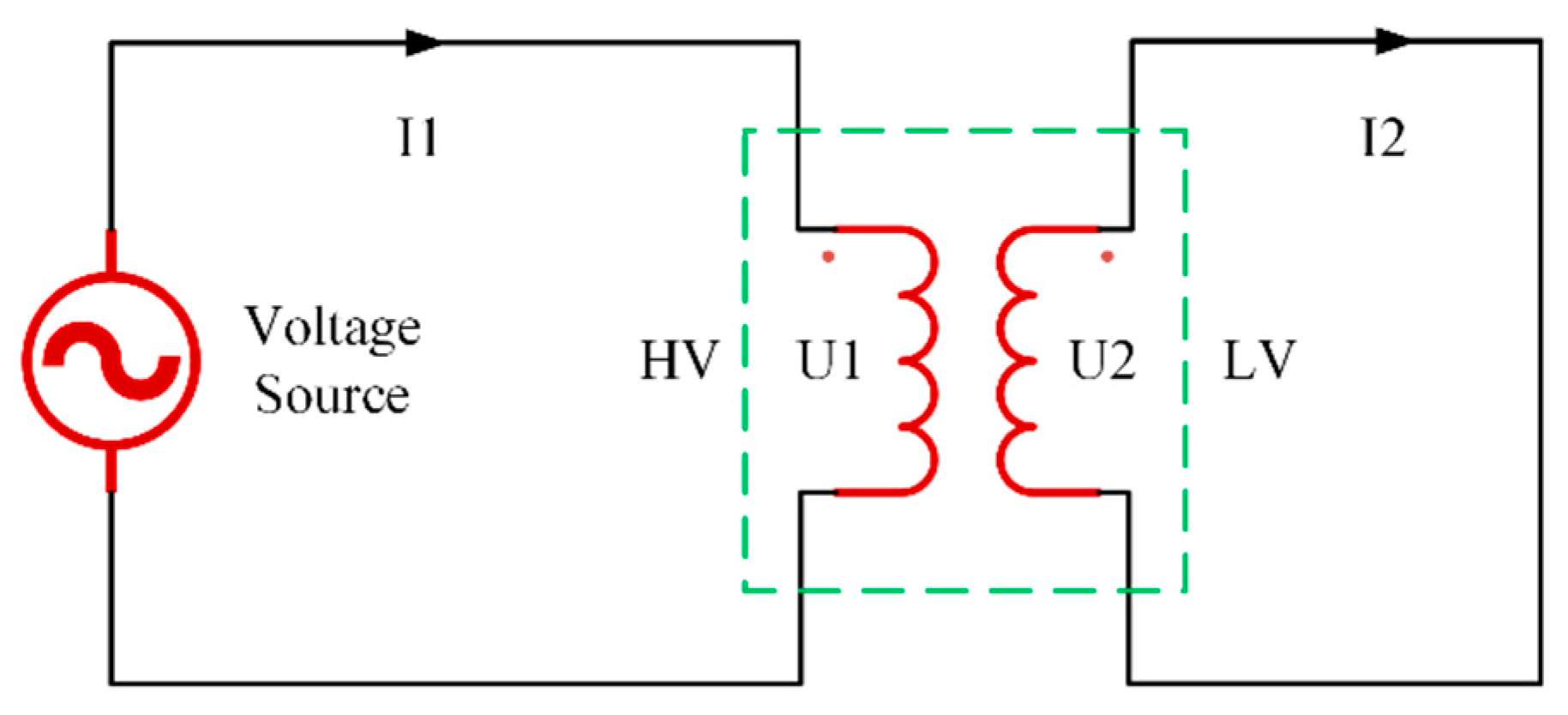


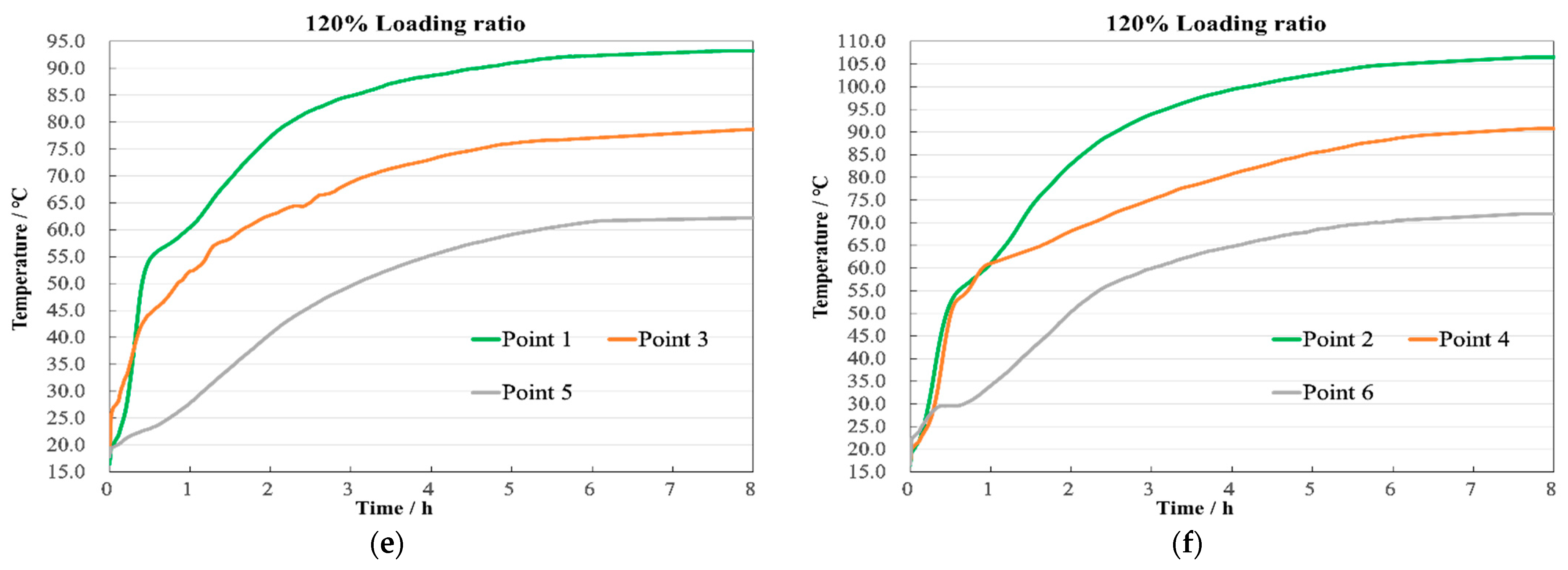
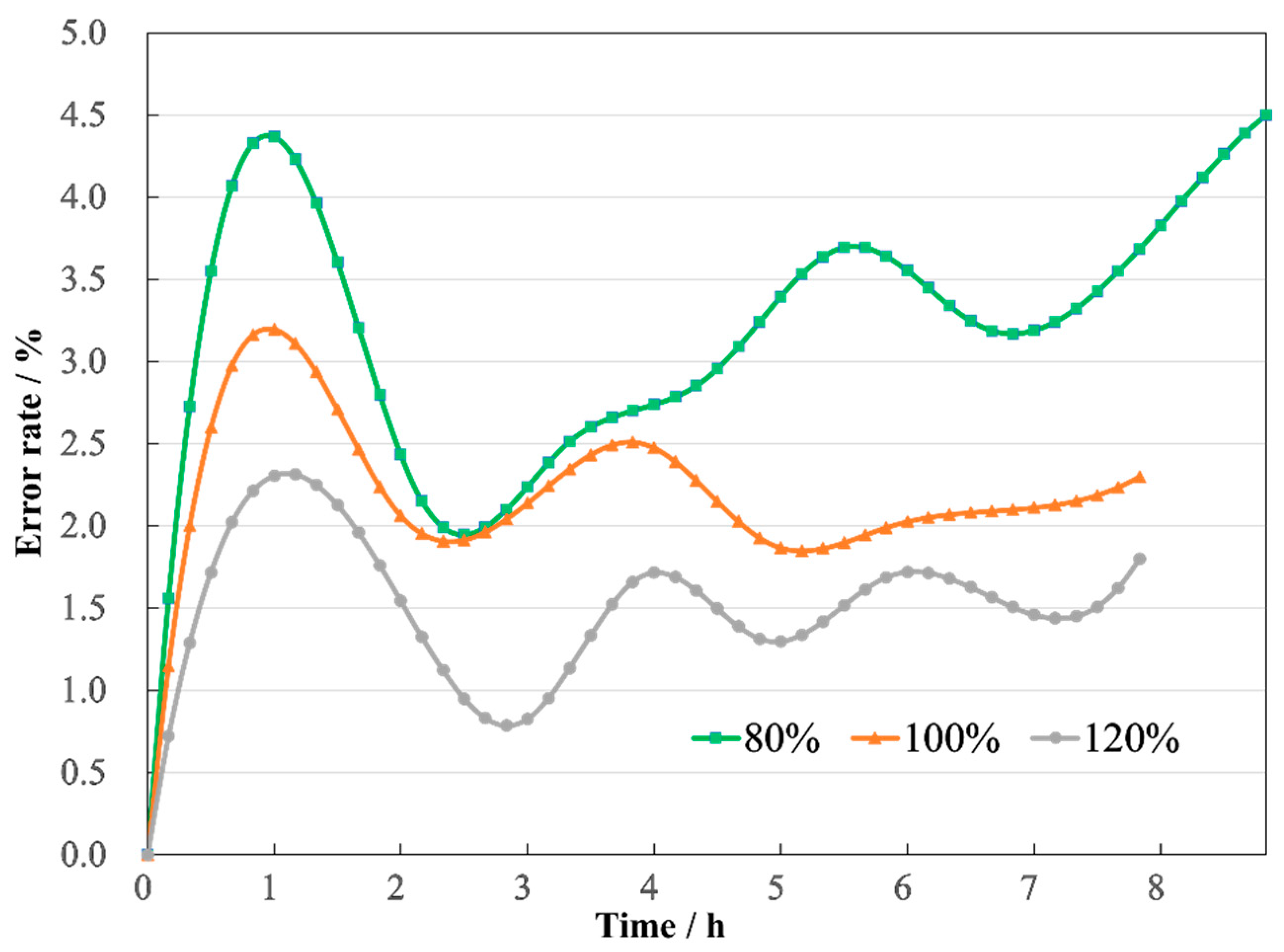
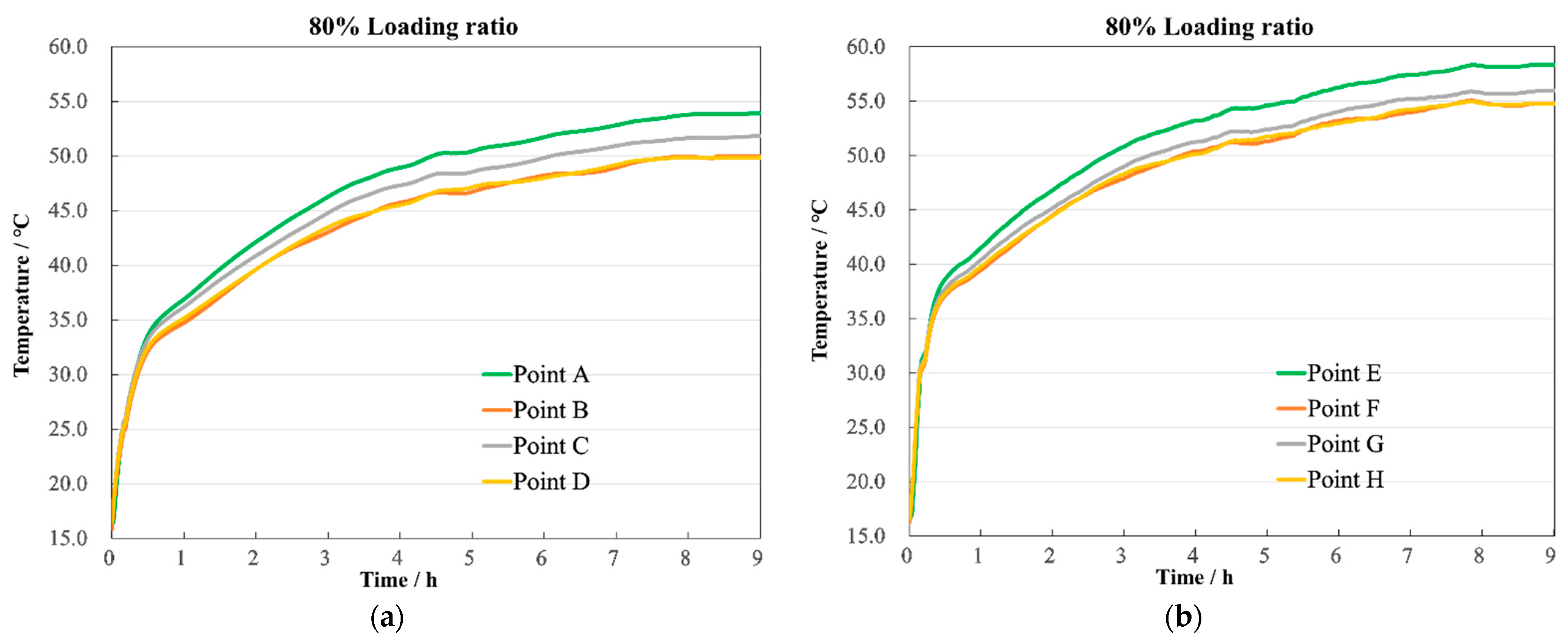

| Parameter | Value | Parameter | Value |
|---|---|---|---|
| Capacity (kVA) | 800 | Core diameter (mm) | 210 |
| Frequency (Hz) | 50 | Core window height (mm) | 640 |
| Cooling method | ONAN | HV winding turns | 2 × 440 |
| Voltage level (kV) | 35/10.5 | LV winding turns | 2933 |
| HV rated current (A) | 11.43 | LV rated current (A) | 76.2 |
| HV connection mode | Parallel | LV connection mode | Series |
| Material | Parameter | Values |
|---|---|---|
| Insulation oil | Density ρ (kg/m3) | 1098.72–0.712 T |
| Coefficient of thermal conductivity λ (W/m·K) | 0.1509–7.01 × 10−5 T | |
| Heat capacity at unwavering pressure cp (J/kg·K) | 1745 + 4.2 T | |
| Dynamic viscosity μ (Pa·s) | 0.085–4 × 10−4 T + 5 × 10−7 T2 | |
| Iron core | Density ρ (kg/m3) | 7650 |
| Coefficient of thermal conductivity λ (W/m·K) | 0.1306 | |
| Heat capacity at unwavering pressure cp (J/kg·K) | 1890 | |
| Windings | Heat capacity at unwavering pressure (J/kg·K) | 376.98–3.2 × 10−4 T2 + 0.221 T |
| Coefficient of thermal conductivity (W/m·K) | 404.18 + 8.64 × 10−5 T2–0.104 T | |
| Density ρ (kg/m3) | 8900 | |
| Coefficient of thermal conductivity λ (W/m·K) | 338 | |
| Heat capacity at unwavering pressure cp (J/kg·K) | 390 | |
| Insulation paperboards | Density ρ (kg/m3) | 1200 |
| Coefficient of thermal conductivity λ (W/m·K) | 0.03 | |
| Heat capacity at unwavering pressure cp (J/kg·K) | 2000 |
| Loading Ratio | Location | HV Temperature (°C) | LV Temperature (°C) | ||||
|---|---|---|---|---|---|---|---|
| Test | Simulation | Errors | Test | Simulation | Errors | ||
| 80% | Top | 53.90 | 55.80 | 1.90 | 58.35 | 60.20 | 1.85 |
| Middle | 46.28 | 48.10 | 1.82 | 48.20 | 49.94 | 1.74 | |
| Bottom | 36.37 | 38.06 | 1.69 | 44.78 | 46.43 | 1.65 | |
| 100% | Top | 76.11 | 77.80 | 1.70 | 87.20 | 88.60 | 1.40 |
| Middle | 65.03 | 66.71 | 1.67 | 73.78 | 75.51 | 1.73 | |
| Bottom | 51.19 | 52.85 | 1.66 | 58.96 | 60.60 | 1.64 | |
| 120% | Top | 93.23 | 94.97 | 1.74 | 106.50 | 108.21 | 1.71 |
| Middle | 78.65 | 80.24 | 1.59 | 90.77 | 92.45 | 1.68 | |
| Bottom | 62.20 | 63.90 | 1.69 | 71.98 | 73.71 | 1.73 | |
Disclaimer/Publisher’s Note: The statements, opinions and data contained in all publications are solely those of the individual author(s) and contributor(s) and not of MDPI and/or the editor(s). MDPI and/or the editor(s) disclaim responsibility for any injury to people or property resulting from any ideas, methods, instructions or products referred to in the content. |
© 2024 by the authors. Licensee MDPI, Basel, Switzerland. This article is an open access article distributed under the terms and conditions of the Creative Commons Attribution (CC BY) license (https://creativecommons.org/licenses/by/4.0/).
Share and Cite
Yang, F.; Gao, S.; Wang, G.; Hao, H.; Wang, P. Full-Scale Modeling and FBGs Experimental Measurements for Thermal Analysis of Converter Transformer. Sensors 2024, 24, 3071. https://doi.org/10.3390/s24103071
Yang F, Gao S, Wang G, Hao H, Wang P. Full-Scale Modeling and FBGs Experimental Measurements for Thermal Analysis of Converter Transformer. Sensors. 2024; 24(10):3071. https://doi.org/10.3390/s24103071
Chicago/Turabian StyleYang, Fan, Sance Gao, Gepeng Wang, Hanxue Hao, and Pengbo Wang. 2024. "Full-Scale Modeling and FBGs Experimental Measurements for Thermal Analysis of Converter Transformer" Sensors 24, no. 10: 3071. https://doi.org/10.3390/s24103071
APA StyleYang, F., Gao, S., Wang, G., Hao, H., & Wang, P. (2024). Full-Scale Modeling and FBGs Experimental Measurements for Thermal Analysis of Converter Transformer. Sensors, 24(10), 3071. https://doi.org/10.3390/s24103071





